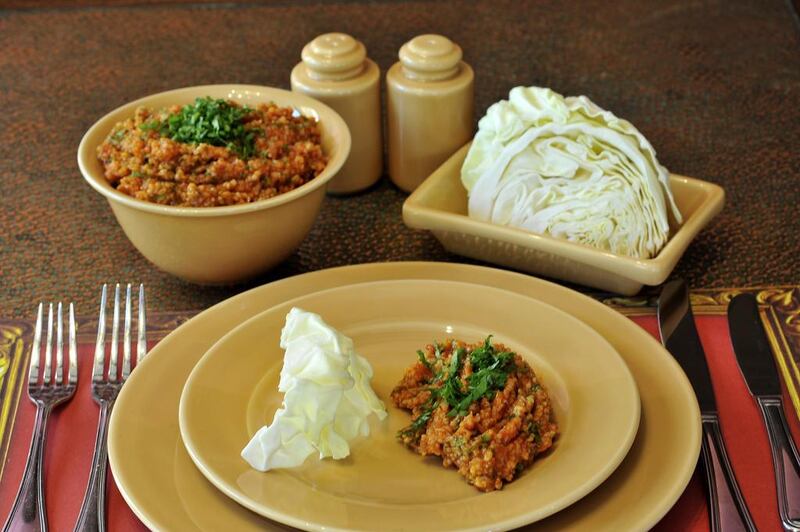An exceptionally rambunctious child, it seemed the only time Aline Kamakian slowed down was to help her grandmother, Manouchag, prepare a weekend Armenian feast for the entire family.
In the kitchen, she and her cousins formed an assembly line, each youngster given an individual responsibility such as washing parsley, rolling pastry or chopping onions. The resultant dishes could vary in quality, but that never bothered Manouchag.
“She’d say: ‘Just put your heart in it and it will be great.’ Even the worst things we made, my grandmother would proudly put them on the dinner table,” says Kamakian.
Now, using her grandmother’s recipes, Kamakian and her cousin Serge Maacaron have opened a rarity: a homespun Armenian restaurant in Dubai called Mayrig (meaning “mother” in Armenian). With her shock of curly red hair and warm smile, the insurance broker has become something of an ambassador for Armenian food, introducing the formerly homebound cuisine to a wider audience and also writing a book on the subject.
Though Manouchag died in 1984, the routine of a Sunday dinner with the family continued. It was during one such gathering in 2003 that Kamakian and Maacaron, disappointed with Beirut’s dining scene, decided that the Armenian food made in their homes was better than any restaurant’s and it was time other people knew it, too.
The following Wednesday they found their first location in Beirut, opening the restaurant a mere four months later. For the first six years Kamakian worked in the kitchen, alongside Maacaron and a staff of 30, while simultaneously running her insurance brokerage, Insurance Investment Consultants.
“I would take calls on my earpiece while I was cooking. Sometimes I’d say: ‘Pass me the salt,’ and the client would say: ‘What?’ My insurance clients never knew that I had this other job,” she says.
Building on their early experiences in Manouchag’s kitchen, Maacaron and Kamakian formed a symbiotic partnership. She shone at preparing savoury foods and managing the restaurant’s operations. Maacaron excelled at presentation and crafting desserts.
The success of the Beirut location prompted the pair to open Mayrig Jeddah in 2011, followed by Dubai in October this year. With quirky decor and family photographs adorning the walls, each restaurant retains the intimacy of a home.
If the food tastes homemade, that’s because it is. Everything is made from scratch with natural ingredients. The dishes that require more handwork such as “manti” (lamb dumplings) and “su beureg” (noodle-like pastry layered with cheese) are still made in the Beirut kitchen by a staff of “mamas”, Armenian women in their 50s and 60s, many of whom were previously homemakers or domestic helpers.
Kamakian’s unusual choice in staffing is simple: “Because I wanted to taste the motherhood love in the food,” she says.
The intertwined concepts of motherhood, food and love are Manouchag’s legacy. Those weekend family gatherings were especially precious when compared with her own childhood as a survivor of the Armenian genocide.
In the beginning of the 20th century, the majority of Armenians lived within the Ottoman Empire. The reformist government of Young Turks, in an effort to unify the disintegrating empire, began the systematic expulsion of Christian minorities including Armenians, Assyrians and Greeks.
It is estimated that between 1 and 1.5 million Armenians were killed. Tens of thousands more were displaced, many of whom resettled in the Levant. For most, it continues to be the most traumatic period in Armenian history.
Manouchag was seven in 1915, the year of the genocide, one of countless children orphaned by the conflict. Rescued by French allied warships, she grew up in an orphanage in Cyprus before relocating to Beirut in 1932 to teach at the Armenian school. Food played an essential role in Manouchag’s memories of Armenia.
“She left at such a young age, so she would tell us stories of where she would play. She described the house, what she remembers of the food and the smell of the house. It was very emotional. Food and emotion are so much linked,” Kamakian recollects.
The Armenia of Manouchag’s childhood was a place that her grandchildren would never visit. More than just a shared family meal, those weekend gatherings in Manouchag’s Beirut home were a way of preserving the history and culture of a homeland that no longer existed. The borders had long been redrawn, with the Mediterranean portion of Armenia incorporated into Turkey and the rest into the Soviet Union.
“It was through food and through our language that we kept our history. Despite all the difficulties of our people, through the food we kept our traditions gathered together and then got the memory of Armenia,” Kamakian says.
In the diaspora, Armenian cuisine has evolved and adapted over time, picking up ingredients and cooking styles from each host country. Many dishes refer to regions in their former homeland, the “Urfa kebab”, named after the town in south-eastern Turkey or “Musa Dagh harissa”, the site of the Armenian resistance now part of the Turkish Hatay province near the Syrian border. The resilience of Armenian culture in the diaspora despite statelessness can be credited, in part, to Armenian mothers and grandmothers who have handed down recipes, along with stories of survival, to the next generation.
This is what inspired Kamakian to write Armenian Cuisine. Published last year, part cookbook and part ethnography, it archives a tapestry of regional recipes and documents some families' oral history. Each chapter chronicles a woman from a different part of Armenia, including a narrative of her family's escape and recipes that have been handed down to her.
To research the book, Kamakian teamed up with the anthropologist Barbara Dreskens, backpacking through regions that were known as the “Armenian Kingdom of Cilicia” in the Middle Ages, now the southeastern coast of Turkey.
“When I first asked about Armenians it was as if I was asking a taboo question. Many no longer speak Armenian. Or, their name has changed. And, at first they refused to acknowledge they could be Armenian,” Kamakian says.
The trip was an emotional experience for Kamakian. The knowledge of the violence that had transpired there haunted her. Witnessing the obliteration of her heritage and its replacement with a revisionist history made the pain more acute.
She writes in her book: “We saw beautiful churches, deserted and in decay, used as stables for cows or left to the carelessness of birds on an isolated island… The signs in English and Turkish do not mention the Armenians.”
During this trip, she was also able to visit the site of Manouchag’s home, piecing together a destination based on recollections of snippets of conversation. “To see her home was a confusion of emotions. I felt anger and bitterness, but in the most beautiful location. The first thing I wished is that I could have brought my grandmother,” she says.
As the centennial of the genocide draws closer, the book and the restaurant are emblematic of Kamakian’s generation, the third to have been raised in the diaspora, eager to reclaim their culture. “The first generation’s aim was to survive. The second generation’s aim was to adapt and learn the language. We are looking for our tradition. We want to show people who we are,” she says.
This article has been amended to reflect that Mayrig is not the first Armenian restaurant in the UAE.
Itch, bulghur and tomato salad
From Aline Kamakian's cookbook Armenian Cuisine
“In the early summer we used to gather with friends and family to prepare itch. To make this salad, you really need good sun-ripened tomatoes and fresh, young vine leaves. The first itch of the year is eaten with cabbage. Instead, we use the vine leaves to grab a bite with our fingers. The first itch gathering of summer was always a feast.”
Ingredients
3 ripe tomatoes, peeled and diced
1 onion, finely chopped
¼ green bell pepper
½ cup medium white bulghur
1 cup water
2-4 tbsp olive oil
1 tsp salt
1 tbsp hot red pepper paste
½ tsp seven spices (mix of allspice, cinnamon, cloves, coriander, nutmeg, white pepper, black pepper)
2 tbsp chopped parsley
2 spring onions
3 fresh mint leaves, finely chopped
Preparation
Fry the onion in two tablespoons of olive oil for one minute.
Add the green pepper and fry for another four minutes.
Stir the tomatoes into the mixture and simmer.
After two minutes, add the pepper paste, the water, the seven-spice mixture and the salt. Simmer for 10 minutes.
Stir the bulghur through the tomato mixture, remove from heat and let it rest for 10 minutes.
Combine with one tablespoon of lemon juice and let it cool further.
When the mixture is cold, stir in the parsley, mint and the spring onions as well as some extra olive oil, according to taste.
Serve with white cabbage or fresh, young vine leaves.
• Mayrig is located in Downtown Dubai on Sheikh Mohammed bin Rashid Boulevard. Call 056 364 9794. Kamakian’s cookbook Armenian Cuisine can be purchased at the restaurant or Kinokuniya in The Dubai Mall






